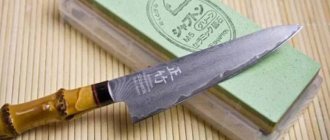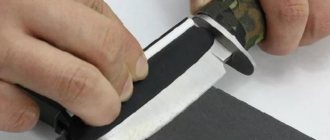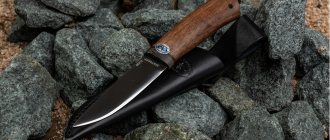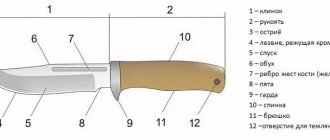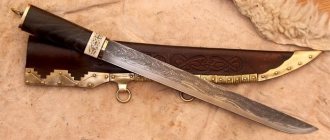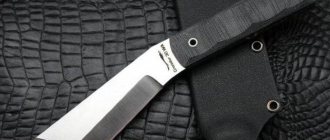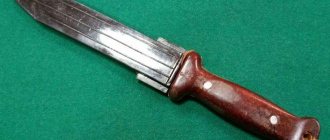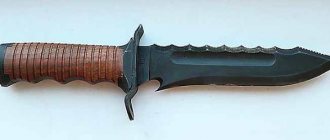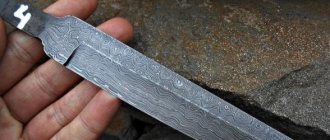Do not believe the assurances that knives are self-sharpening and do not require additional sharpening. This is nothing more than a marketing ploy. But the intervals between sharpenings can indeed be different - from a week (economy class products made in China) to a year or more (premium knives from Japanese brands). With each sharpening, a certain amount of steel shavings is removed, so if the procedure is carried out too often and incorrectly, the cutting edge will quickly wear out and the tool will fail. But don’t be afraid to sharpen knives yourself - if you do everything correctly, the blade will regain its sharpness and retain it for a long time.
Choosing a stone
The stores offer different types of sharpening stones - ceramic (boats), diamond, water stones. There are also tools for regularly editing the blade - musats. They are a long rod with a handle.
What is the best way to sharpen knives so that they last as long as possible? For professional Japanese tools with steel blades, only water stones are suitable. These products are distinguished by an extremely thin cutting edge, and when wet sharpening, a minimum of metal shavings are removed. The use of musats is also relevant, but only for periodic “corrections” and polishing of a blade that has not yet become dull. This allows you to extend the period when sharpening is not required.
Water stones are classified by grain size. This indicator is marked with # or grit. According to the degree of grain size, water stones are:
- Rough (up to #1000). Used to shape the cutting edge and restore the desired sharpening angle.
- Medium (#1000-3000). Used for basic sharpening to make the blade sharp.
- Thin (more than #3000). Required for final straightening of the blade at the final stage of sharpening.
For proper step-by-step processing of the blade, it is advisable to purchase bars of each type.
As for the parameters of the stone, experts recommend choosing a block whose length exceeds the length of the blade by no more than 1.5-2 times. The thickness of the stone does not affect the sharpening process, but thicker products will last longer and are more convenient to work with. However, a thin block can be glued to a wooden base to make it easier to use.
Another important indicator is the hardness of the grindstone. Soft bars are cheaper, but during sharpening a suspension of water and stone particles is formed on the surface, which scratches the blade. In addition, soft stones wear out faster.
How to determine the correct knife sharpening angle
The smaller the angle, the sharper the knife. However, you should not change the angle specified by the manufacturer. This can lead to geometry violations and negatively affect the quality of the cut. To understand at what angle to sharpen a knife, remember where it was made. For Japanese products, the minimum angle is 15-20 degrees, for European ones it is 30-45. If you find it difficult to identify, use the following methods for determining the sharpening angles of kitchen knives:
- Place the cutting edge into the scissors. Fix the half-open blades of the scissors in a given position and measure the angle with a protractor. To prevent the scissors from moving before the measurement, tighten the fastening bolt to the limit.
- Use paraffin. Apply a layer of paraffin wax to the work board and stick the blade into it. Wait for the paraffin to harden and remove the blade. Take a photo of the resulting hole and measure the angle.
- And of course, the easiest way is to ask a question to the manufacturer.
Sharpening instructions
Using water stones, you can sharpen knives by hand in your home kitchen. It is important to sharpen in stages, following the technology. Consider the following nuances:
- You need to wet the block before starting work so that the blade glides smoothly, during the process - to remove the resulting suspension, and after - to clean the stone.
- Do not put any force on the blade, as you risk deforming the stone and removing too many chips from the cutting edge.
- It is necessary to constantly follow the selected sharpening angle. It is most convenient to use special devices for this - sharpening angle holders.
- They always start work with a coarse-grained stone and finish with a fine-grained one.
- If this is your first time, practice on a knife that you don't mind ruining.
Now let's figure out how to properly sharpen knives with a whetstone. The process includes the following steps:
- Preparation. Wash, dry thoroughly and dry the knife. Treating a dirty or greasy surface is unproductive. The whetstone must be soaked in water. Use a non-food container. Each stone must be soaked separately so that the separated particles do not settle on stones of different fractions. The soaking time depends on the grain size. Rough stones are placed in water for 3-5 minutes, medium stones for 10-15, thin stones for 20-30 minutes. You can begin work when air bubbles stop rising from the surface of the soaked stone. Prepare your work area. You can use an old wooden board as a stand or lay out a towel. It is convenient to sharpen using a block clamp.
- Setting the sharpening angle. Set the desired value on the sharpening angle holder, if you have one. If not, you can fold a piece of paper to get the desired angle and hold it under the blade.
- Sharpening. When sharpening on one side, the blade is sharpened along the line of the protruding descent until a burr appears on the opposite side. This usually requires 40-50 movements. When going forward, lightly press the knife, when going backwards, release the pressure. Then use the opposite side to rub the stone several times to remove the burr. When sharpening blades on both sides, first one side is processed until a burr appears, then the other. Mentally divide the blade into 2-3 equal parts and sharpen each section in turn. During initial rough processing, it is important to remove mechanical damage, if any. If the blade is not damaged, you can start straight away with a medium-grain stone so as not to remove excess chips from the surface.
- Final sharpening. Processing with fine-grained stone is necessary for the ideal sharpness of the blade. Proceed similarly to the previous step. In this case, a burr usually does not form.
- Checking the result. Never test the sharpness of the blade with your finger. The risk of cutting is too high. Use a tomato to assess the quality of the cut - the edge of the product should not wrinkle, but remain perfectly smooth. Another option is to cut a sheet of paper on the fly. A sharp knife will cope with this task flawlessly.
How to sharpen ceramic knives
Ceramic knives are made from zirconium ore with various additives. This blade is very hard, durable and wear-resistant. During production, sharpening is carried out industrially and, with proper use, it lasts for several years. However, sooner or later there may be a need to sharpen this tool too. Ceramic blades are sharpened with diamond-coated devices (stones, sharpeners). It should also be taken into account that ceramic knives have a sharper sharpening angle than steel knives - about 40-45 degrees. Sharpening is carried out in one stage using a diamond stone or a sharpener with diamond abrasive. The main disadvantage of a ceramic knife is the fragility of the hard blade. If a chip or crack has formed on it, it will not be possible to correct the damage during sharpening. Therefore, such kitchen tools require delicate handling, including when sharpening. Be careful not to press too hard on the blade. Otherwise, the sharpening technique is the same as for steel blades.
Features of professional sharpening machines
Such equipment has several technical and operational differences from household analogues. But it’s worth emphasizing right away that the cost of this machine can be 2-3 times higher than models for home use.
So, we are talking about more productive, functional and precise units that can confidently adjust the shape of an edge made of tool and high-speed steel. As a rule, professional electric knife sharpeners have a durable metal base, a balanced rotor, almost always the ability to install two wheels, and a powerful three-phase motor.
In terms of functionality, it is worth emphasizing the possibility of adjusting the reach, point-by-point adjustment to the dimensions of the tool being processed, and automatic wetting of the working equipment, which protects it from overheating.
Alternative sharpening methods
For home use, many consumers choose a simpler sharpening method - using sharpeners or knifes. They are easy to use, safe and do not require special skills. Some models have the ability to set the desired sharpening angle. However, such devices have a drawback - unlike manual processing, they remove a large amount of metal shavings and the tool wears out faster. There are several types of sharpeners:
- Universal. Roller, table, V-shaped - with their help you can sharpen and straighten the blades of knives and scissors.
- Electrical. They sharpen quickly and efficiently, and can be equipped with coarse and fine sharpening functions.
- Mechanical. The most budget-friendly, for manual sharpening. They are used instead of bars and may have finger guides.
Consumers often wonder whether it is possible to sharpen a knife with a knife. This is acceptable when both blades are made of the same type of steel. But this method is not sharpening. Rather, this is a procedure similar to processing with musat - it only “corrects” the cutting edge. It is unlikely that the average person can sharpen a dull knife in this way. But getting injured is easy. Therefore, it is still better to edit with musat and sharpen with a whetstone or sharpener.
Angle Holding Devices
To ensure that the sharpening angle does not change during operation, the blade must be well secured. There is a huge range of sharpening tools available on the market. The best devices for home use are mechanical sharpening systems with removable stones and the ability to set the angle. The following devices will help maintain the correct sharpening angle of a kitchen knife:
- A stand-holder for stones, on one side of which a certain adjustable slope is provided. Such devices allow you to raise the blade above the surface level and firmly fix it motionless. Since the tool will constantly come into contact with abrasive suspension and moisture, it is better to purchase a stand made of materials that are resistant to corrosion.
- A sharpening machine of the Ruixin Touch Pro type, which is a stand with a clamp (stop) in the form of a plate. The tool is fixed using a bolt with 2 washers, which allows you to set any sharpening angle of the knives as accurately as possible.
Electric sharpeners for home use only have one standard degree of angle (about 30°). Therefore, it is not recommended to use them for knives with a smaller sharpened angle.
Ruixin Touch Pro Steel
Stand holder
Common Mistakes
So, we found out how to properly sharpen knives by hand. Let's list the common mistakes of inexperienced consumers to summarize. Definitely not worth it:
- Place the stone directly on the table, without a backing.
- Use only one water stone for sharpening.
- Wet the stone only once.
- Sharpen dirty and greasy knives.
- Apply excessive pressure on the knife while sharpening.
- Violate the factory sharpening angle.
- Finish sharpening ahead of time without removing the burrs completely.
Such actions can reduce the efficiency of your work or even lead to damage to the blade.
Did you like the article? Have you read to the end?! Using the promotional code Stone we give a DISCOUNT on your purchase in the cart!
The best manufacturers of sharpening machines
In the budget segment, for simple sharpening tasks you can find good offers from domestic manufacturers. These are machines costing up to 3-4 thousand rubles. from brands such as “Vikhr”, “Kraton”, “Caliber”, etc.
The middle and most popular segment is represented by models with a price tag of approximately 5 to 10 thousand from Bosch, Metabo and Makita. According to reviews, one of the best knife sharpening machines in this group is the Bosch GBG 60-20 model. It has balanced characteristics and decent German workmanship.
Private craftsmen and industrial workers will be interested in professional models. This is a narrow, but technologically developing class of sharpening machines from companies such as Inforce and Proma in the BKL line.
